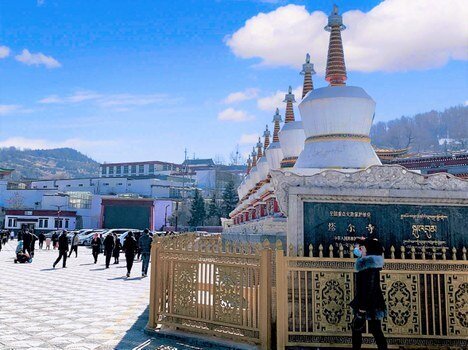Tibetan monasteries barred from organising religious festival
Monasteries in eastern Tibet face restrictions during Choetrul Monlam Chenmo.
Chinese authorities have imposed restrictions on the celebration of a Tibetan religious festival at Labrang Tashi Kyil monastery in Gansu Province, Dargye monastery in Sichuan province, and Rebgong Rongwo monastery and Kumbum monastery in Qinghai province to contain the coronavirus from spreading.
On 12 February, the Epidemic Prevention and Control and Leading Group office issued a notice, stating Labrang monastery will be closed to outside visitors from 12 Feb to 28 February. On 22 February, Kumbum Monastic Management Committee issued a notice that the Kumbum monastery would be closed to outside visitors on 26 February. Thousands of Tibetans have been barred from visiting the festival.
These days all the religious activities in Tibetan monasteries are directly controlled by Monastic Management Committees, which comprises a group of Chinese government officials who are permanently stationed in the monasteries. The committee replaces the centuries-old tradition of senior lamas overseeing the study and practice of Tibetan Buddhism. The policy of Monastic Management Committee, first introduced by Party secretary Chen Quanguo in central Tibet on 4 January 2012, was gradually implemented in eastern Tibet as well.
Even before the pandemic, monasteries were under intense military watch, especially during religious festivals, and Tibetan pilgrims are routinely restricted from attending.
Kumbum Monastery, in Amdo (Ch: Qinghai), was founded by the Third Dalai Lama, Sonam Gyatso, in 1583 at the site of the birthplace of Tsongkhapa Lobzang Drakpa (1357-1419) who is one of the most important figures in the history and philosophy of Tibetan Buddhism. Tsongkhapa introduced the Choetrul Monlam festival in Tibet in the fifteenth century.
Choetrul Duchen commemorates one of the four key events in the life of Buddha, who after being repeatedly challenged by six Indian scholars who wanted to test his knowledge and growing influence, is said to have defeated them through debates and miracles on the fifteenth day of the first month of the lunar calendar. It is also during this festival that the current and fourteenth Dalai Lama, at 23 years old, against the backdrop of the Chinese invasion from eastern Tibet, passed his final exam on Buddhist philosophy in front of thousands of monks in Lhasa’s Jokhang temple. His training on Tibetan Buddhism was tested by 80 learned scholars through vigorous, quick question-answer debates on five subjects: logic, metaphysics, the middle way, the perfection of wisdom, and the canon of monastic discipline.
This year’s Choetrul Duchen, also known as, Monlam Chenmo (The Great Prayer Festival) was observed on 26 February. In Tibet, it is traditionally celebrated by Tibetans by making flowers and butter lamp offerings at the monasteries. The monks also make elaborate butter sculptures for display and perform a ritual dance called Cham (Mask dance) in the courtyard. Large decorated tapestries that recount the life of Buddha are unscrolled on slopes of mountains for the laypeople to seek blessing from. In exile, after many years of re-establishing Tibetan refugee communities and monasteries in exile, the festival was revived and the Dalai Lama would give teachings from Jataka tales, a canon of sacred Buddhist literature, to the audience at the temple gathering.
This year, the prayer festival took place online nonetheless and alongside the usual teaching, the Dalai Lama particularly appealed to the younger generation of Tibetans “to Tibetans in all parts of Tibet to pay attention to our common language. We may speak in different dialects, but the language we read is common between us.”




